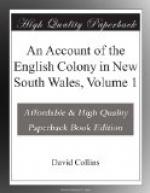Great inconvenience was found from the necessity that subsisted of suffering the stock of individuals to run loose amongst the tents and huts; much damage in particular was sustained by hogs, who frequently forced their way into them while the owners were at labour and destroyed and damaged whatever they met with. At first these losses were usually made good from the store, as it was unreasonable to expect labour where the labourer did not receive the proper sustenance; but this being soon found to open a door to much imposition, and to give rise to many fabricated tales of injuries that never existed, an order was given, that any hog caught trespassing was to be killed by the person who actually received any damage from it.
The principal street of the intended town was marked out at the head of the cove, and its dimensions were extensive. The government-house was to be constructed on the summit of a hill commanding a capital view of Long Cove, and other parts of the harbour; but this was to be a work of after-consideration; for the present, as the ground was not cleared, it was sufficient to point out the situation and define the limits of the future buildings.
On the 19th the Supply returned from Norfolk Island, having been absent four weeks and six days. We learned that she made the island on the 29th of last month, but for the five succeeding days was not able to effect a landing, being prevented by a surf which they found breaking with violence on a reef of rocks that lay across the principal bay. Lieutenant King had nearly given up all hopes of being able to land, when a small opening was discovered in the reef wide enough to admit a boat, through which he was so fortunate as to get safely with all his people and stores. When landed, he could nowhere find a space clear enough for pitching a tent; and he had to cut through an almost impenetrable wilderness before he could encamp himself and his people. Of the flock he carried with him, he lost the only she-goat he had, and one ewe. He had named the bay wherein he landed and fixed the settlement Sydney Bay, and had given the names of Phillip and Nepean to two small islands which are situated at a small distance from it.
Lieutenant King, the commandant, wrote in good spirits, and spoke of meeting all his difficulties like a man determined to overcome them. The soil of the island appeared to be very rich, but the landing dangerous, Sydney Bay being exposed to the southerly winds, with which the surf constantly breaks on the reef. The Supply lost one of her people, who was washed off the reef and drowned. There is a small bay on the other side of the island, but at a distance from the settlement, and no anchoring ground in either. The flax plant (the principal object in view) he had not discovered when the Supply sailed. Lieutenant Ball, soon after he left this harbour, fell in with an uninhabited island in lat. 31 degrees 56 minutes S and in long. 159 degrees 4 minutes East,




